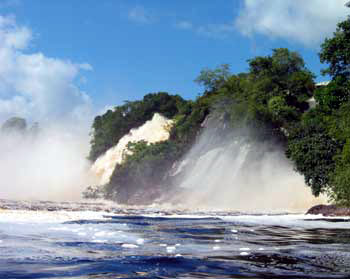From The California Native Newsletter:
Canaima

One of the largest parks in the world, Venezuela’s
Canaima National Park is more than three times the size of Yellowstone
and ten times the size of Yosemite, encompassing almost 12,000 square
miles of tropical jungle, rivers and savannah.
The park’s main destination for visitors is Laguna Canaima, one
of the most beautiful places in Venezuela. Located on a wide, peaceful
stretch of the Rio Carrao, a series of broad cascading waterfalls pour
into the tranquil lagoon. The comfortable lodges, great food, and fantastic
scenery make Laguna Canaima a great place to relax, boat, and hike, including
one trail which leads behind a waterfall. A short walk takes you to a
Pemón Indian village. Laguna Canaima is also the starting place
for the fly-over and boat trips to Angel Falls.
Silhouetted against the blue sky and rising high above Canaima’s
jungle and savannah are the park’s most dramatic feature—the
mysterious tepuys.
In the language of the Pemón Indians, the word tepuy means “table
mountain.” Composed of two billion year old rocks, the ancient
tepuys shelter plants which grow nowhere else in the world—some
unique to only a single tepuy.
The two most well known tepuys are Roraima and Auyantepuy. Roraima, the
highest of the tepuys, was the setting for Sir Arthur Conan Doyle’s
novel, The Lost World. Although no dinosaurs rampage across Roraima’s
top, the strange plants, valleys of crystals, pools of water and weird
rock formations, appear to be from another planet.
From high atop Auyantepuy, the largest of the tepuys, Angel Falls, the
world’s highest waterfall, plunges over 3000 feet to the jungle
below. The falls were named for Jimmy Angel, an American bush pilot and
gold-seeker who first reported the waterfall in 1933.
To the Pemóns, the tepuys are sacred guardians of the savannah where
the “Mawari,” spirits who may steal the souls of the living,
make their home. Around 15,000 Pemóns live in the park where it
is believed their ancestors settled about 200 years ago.
Although the traditions of Pemón society warn against climbing the
tepuys, many of the Indians make their living guiding visitors on backpacking
trips to the tops of these mountains. The gateway for the trek to Roraima
is the Pemón village of Parai Tepuy. All visitors must check in
at this village where supplies for the trek are carefully noted. Upon
returning, empty containers must be produced to insure that no trash
was left on the mountain. Backpacks are also carefully inspected and
weighed to prevent the removal of crystals and minerals from the tepuy.
|



